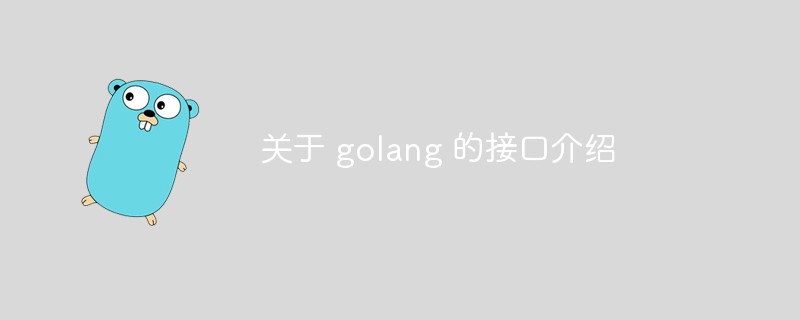Maison >développement back-end >Golang >Introduction à l'interface de Golang
Introduction à l'interface de Golang
- 藏色散人avant
- 2020-09-15 10:21:352677parcourir
La colonne suivante vous présentera l'interface golang de la colonne tutoriel golang J'espère qu'elle sera utile aux amis qui en ont besoin !

En langage Go, l'interface est un type, un type abstrait.
Définition de l'interface
Format de définition :
type 接口类型名 interface{
方法名1( 参数列表1 ) 返回值列表1
方法名2( 参数列表2 ) 返回值列表2
…
}
Lors de la dénomination des interfaces en langage Go, er est généralement ajouté après le mot Il est préférable pour le nom de l'interface. être Mettez en surbrillance la signification du type de l'interface.
Implémentation de l'interface
Tant qu'un objet implémente toutes les méthodes de l'interface, il implémente l'interface.
Différents types en langage Go peuvent implémenter la même interface. (Dans l'exemple, le chien et le chat implémentent l'interface Animal)
//定义一个Animal接口// Animal 是一个动物接口,实现move()和say()方法type Animal interface {
move()
say()
}//定义dog结构体type dog struct {
name string
}//定义cat结构体type cat struct {
name string
}//dog实现move方法func (d dog) move() {
fmt.Printf("%s会跑\n",d.name)
}//dog实现say方法func (d dog) say() {
fmt.Printf("%s会叫汪汪汪\n",d.name)
}//cat实现move方法func (c *cat) move() {
fmt.Printf("%s会跑\n",c.name)
}//cat实现say方法func (c cat) say() {
fmt.Printf("%s会叫喵喵喵\n",c.name)
}func main() { var a Animal //声明一个Animal类型的a //实例化一个dog结构体
d := dog{name:"旺财"}
fmt.Printf("%T\n", d) //main.dog
d.move() //旺财会跑
d.say() //旺财会叫汪汪汪
a = d // 接口是一种类型,一种抽象的类型。
fmt.Println(a) //{旺财} //实例化一个cat结构体
c := cat{name:"蓝猫"}
c.move() //蓝猫会跑
c.say() //蓝猫会叫喵喵喵
}
Polymorphisme
Le langage GO simule le polymorphisme via des interfaces.
Relation entre types et interfaces
Un type peut implémenter plusieurs interfaces en même temps, et les interfaces sont indépendantes les unes des autres et ne connaissent pas l'implémentation de chacune.
Différents types en langage Go peuvent implémenter la même interface.
Imbrication d'interfaces
Les interfaces peuvent créer de nouvelles interfaces grâce à l'imbrication.
//定义speaker接口type speaker interface {
speak()
}//定义mover接口type mover interface {
move()
}// 接口嵌套type animal interface {
speaker
mover
}//定义cat结构体type cat struct {
name string
}//cat是值类型接收者func (c cat) speak() {
fmt.Println("喵喵喵")
}func (c cat) move() {
fmt.Println("猫会动")
}func main() { var x animal
x = cat{name: "花花"}
x.move() //猫会动
x.speak() //喵喵喵
}
Interface vide
Définition de l'interface vide
L'interface vide fait référence à une interface qui ne définit aucune méthode. Les variables de type interface vide peuvent stocker des variables de n'importe quel type.
//空接口func main() { var x interface{}
x = 100 //int类型
fmt.Println(x) //100
x = "ares" //string类型
fmt.Println(x) //ares
x = struct { //结构体类型
name string
}{name:"ares"} //结构体赋值
fmt.Println(x) //ares
}
Application d'interface vide
L'interface vide peut être utilisée comme paramètre de fonction ou comme valeur de carte.
//空接口func showType(a interface{}) {
fmt.Printf("type:%T\n", a)
}func main() { //空接口作为函数的参数
showType(100) //type:int
showType("ares") //type:string //定义一个值为空接口的map var stu = make(map[string]interface{},100)
stu["ares"] = 100
stu["ares1"] = "男"
fmt.Println(stu) //map[ares:100 ares1:男] //map,key是字符串,value是任意类型
map1 := make(map[string]interface{})
map1["name"] = "ares"
map1["age"] = 18
map1["id"] = 1
map1["friend"] = struct {
name string
age int
}{"jay", 33}
fmt.Println(map1) //map[age:18 friend:{jay 33} id:1 name:ares]
}
L'imbrication d'interfaces
est similaire à l'héritage.
type A interface {
test1()
}type B interface {
test2()
}type C interface {
A
B
test3()
}type Cat struct { //如果要实现接口c,需要将接口a和接口b中的方法一起实现
}func (c Cat) test1() {
fmt.Println("test1...")
}func (c Cat) test2() {
fmt.Println("test2...")
}func (c Cat) test3() {
fmt.Println("test3...")
}func main() { var cat = Cat{}
cat.test1() //test1...
cat.test2() //test2...
cat.test3() //test3... //将cat赋值接口A类型,则只能使用test1方法 var cat1 A = Cat{}
cat1.test1() //test1... //将cat赋值接口B类型,则只能使用test2方法 var cat2 B = Cat{}
cat2.test2() //test2...
}
Assertion de type
Syntaxe :
x.(T)
x : Représente une variable de type interface{}
T : Indique le type possible d'assertion x
Si vrai, cela indique que l'assertion est réussie, et si elle est fausse, cela indique que l'assertion échoue.
//类型断言func justifyType(x interface{}) { switch v := x.(type) { case string:
fmt.Printf("x is a string,value is %v\n", v) case int:
fmt.Printf("x is a int is %v\n", v) case bool:
fmt.Printf("x is a bool is %v\n", v) case *string:
fmt.Printf("x is a point指针 is %v\n", v) case struct{}:
fmt.Printf("x is a struct is %v\n", v) default:
fmt.Println("unsupport type!")
}}func main() {
justifyType(100) //x is a int is 100
justifyType("ares") //x is a string,value is ares
justifyType(false) //x is a bool is false
x := "ares"
justifyType(&x) //x is a point指针 is 0xc000094010
justifyType(struct {}{}) //x is a struct is {}
justifyType([]int{123}) //unsupport type!
}
La différence entre le récepteur de valeur et le récepteur de pointeurinterface d'implémentation
Si le récepteur est de type pointeur, la valeur ne peut pas être Passez-le.
//定义animal接口type animal interface {
speak()
move()
}//定义cat结构体type cat struct{
name string
}//定义dog结构体type dog struct{
name string
}//值接收者
func (c cat) speak() {
fmt.Printf("%s会叫喵喵喵\n",c.name)
} func (c cat) move() {
fmt.Printf("%s会动\n",c.name)
} //指针接收者func (d *dog) speak() {
fmt.Printf("%s会叫汪汪汪\n",d.name)
}func (d *dog) move() {
fmt.Printf("%s会动\n",d.name)
}func main() { var c1 animal
lm := cat{name:"蓝猫"}
c1 = lm //因为实现animal接口的是cat值类型,所以可以直接赋值
c1.move() //蓝猫会动
c1.speak() //蓝猫会叫喵喵喵 var c2 animal
jm := &dog{name:"金毛"} //现animal接口的是*dog类型,所以必须要通过&来取值
c2 = jm
c2.move() //金毛会动
c2.speak() //金毛会叫汪汪汪
}Ce qui précède est le contenu détaillé de. pour plus d'informations, suivez d'autres articles connexes sur le site Web de PHP en chinois!

